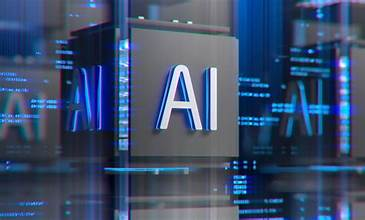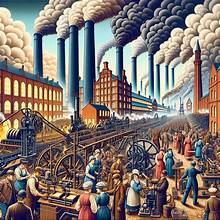Industrial Artificial Intelligence (AI) is changing the way U.S. Policies of companies manufacture, manage, and grow. From smarter robots on factory floors to AI-powered supply chain systems, the adoption of Industrial AI is speeding up across the country. But it’s not just about technology. Behind this transformation lies a network of forward-thinking government policies designed to support innovation, growth, and national competitiveness.
In this article, we’ll explore how U.S. policies are enabling Industrial AI and helping the nation’s industry become more productive, efficient, and globally competitive.
What Is Industrial AI and Why It Matters
Industrial AI refers to the use of artificial intelligence in manufacturing, energy, transportation, and other core industrial sectors. Unlike consumer-facing AI applications, Industrial AI focuses on improving operations, reducing downtime, predicting equipment failure, and making complex decisions quickly.

With global competitors like China and Germany investing heavily in smart manufacturing, it’s crucial for the U.S. to stay ahead. Thankfully, government policies are playing a key role in enabling this shift.
Key Policies Driving Industrial AI in the U.S.
1. CHIPS and Science Act (2022)
The CHIPS and Science Act provides over $50 billion to strengthen U.S. semiconductor manufacturing. These chips are the “brains” of AI systems. By making the U.S. a leader in chip production, this act lays the groundwork for more reliable, powerful AI technologies used in factories.
2. National AI Initiative Act of 2020
This law created a unified national strategy for AI research and deployment. It promotes collaboration between the federal government, academia, and industry. One of its main goals is to boost AI use in sectors like manufacturing, logistics, and energy—directly supporting Industrial AI adoption.
3. AI Research Resource Task Force (2023)
Launched by the National Science Foundation, this task force ensures that small and medium-sized companies can access cutting-edge AI tools and research. This helps spread AI adoption beyond just large corporations, benefiting the entire industrial ecosystem.
4. National Institute of Standards and Technology (NIST) AI Framework
NIST developed a Risk Management Framework for AI to ensure safe and trustworthy use of AI. This helps industries deploy AI with more confidence, knowing they are meeting ethical and safety standards.
5. Manufacturing USA Initiative
The federal government funds Manufacturing USA, a network of innovation institutes that focus on advanced manufacturing, including Industrial AI. These centers provide training, tools, and partnerships that help companies integrate AI into their processes faster and more affordably.
How These Policies Are Transforming Industry

Industrial AI is not just a buzzword—it’s a game changer. These policies have real-world effects on factories, supply chains, and workers.
- Improved Productivity: AI can analyze large datasets in seconds, helping factories optimize production schedules, reduce energy use, and identify quality issues faster than humans.
- Predictive Maintenance: Machines break down less often because AI can predict failures before they happen, saving companies millions in downtime.
- Workforce Upskilling: Through federal training initiatives, workers are learning how to operate and manage AI-powered tools, leading to better jobs and higher wages.
- Resilient Supply Chains: AI helps U.S. companies manage supply chains more efficiently by predicting delays and adjusting inventory in real-time.
Challenges That Still Need Attention
Even with strong government support, some challenges remain:
- Data Privacy and Security: As factories collect more data, the risk of cyberattacks grows. Policies need to evolve to protect sensitive industrial data.
- Skills Gap: While training is increasing, there’s still a shortage of AI-literate workers in many regions.
- SME Inclusion: Small and medium-sized enterprises (SMEs) may struggle to afford and implement Industrial AI. More grants and public-private partnerships are needed.
Looking Ahead: What the Future Holds
The U.S. is well-positioned to lead the next industrial revolution. With the right mix of innovation, investment, and regulation, Industrial AI could add trillions to the economy, create high-paying jobs, and make U.S. industries more sustainable.
Experts believe the next steps should focus on:
- Expanding broadband and 5G access to support AI deployment in rural factories.
- Funding AI-focused education programs at technical colleges.
- Supporting research into ethical and explainable AI for industry.
By continuing to back Industrial AI through smart, inclusive policies, the U.S. can maintain its global leadership and secure a better future for its workers and businesses.
Conclusion: Policy and AI Go Hand-in-Hand
Technology alone isn’t enough to transform industry. It needs the right environment to grow. U.S. government policies are making that environment possible—funding research, building infrastructure, training workers, and managing risk. As a result, Industrial AI is no longer a far-off dream. It’s here, it’s working, and it’s moving American industry forward.
To stay competitive in the age of smart manufacturing, businesses must continue to watch policy developments and prepare to adapt quickly. With government support and industry innovation working together, the future looks bright for Industrial AI in the United States.
Suggestions
- CHIPS and Science Act – White House
- National AI Initiative Act Summary
- NSF AI Research Resource Task Force
- NIST AI Risk Management Framework
- Manufacturing USA Official Website
Also Read – Real Estate Expert Reveals 4 Home Types Buyers Really Want Today





